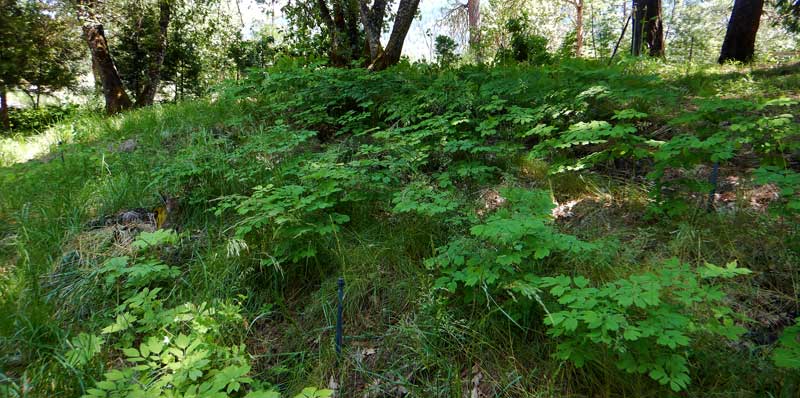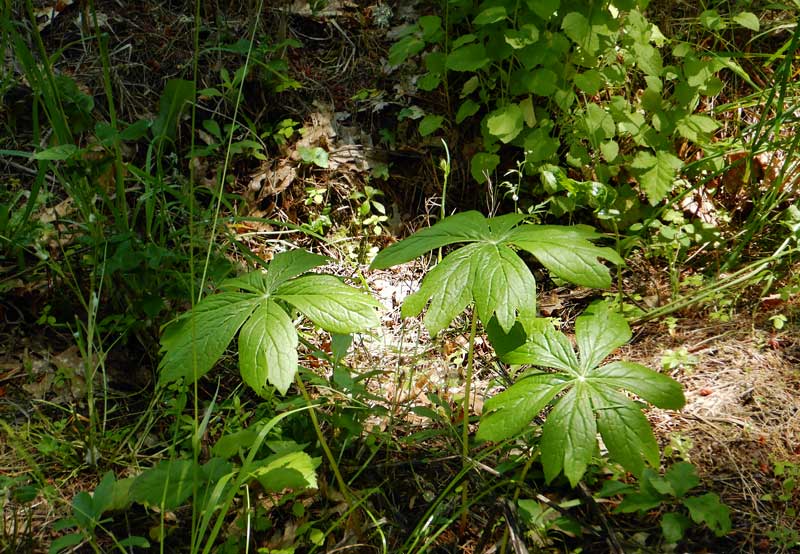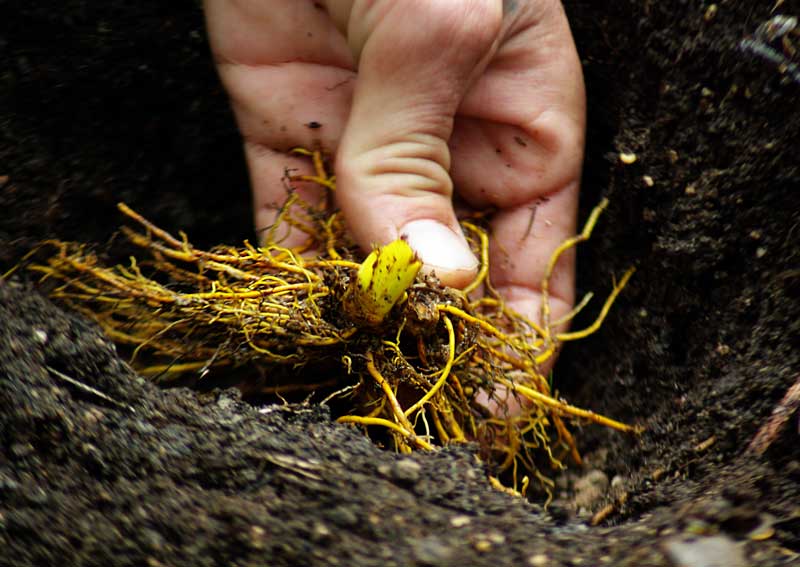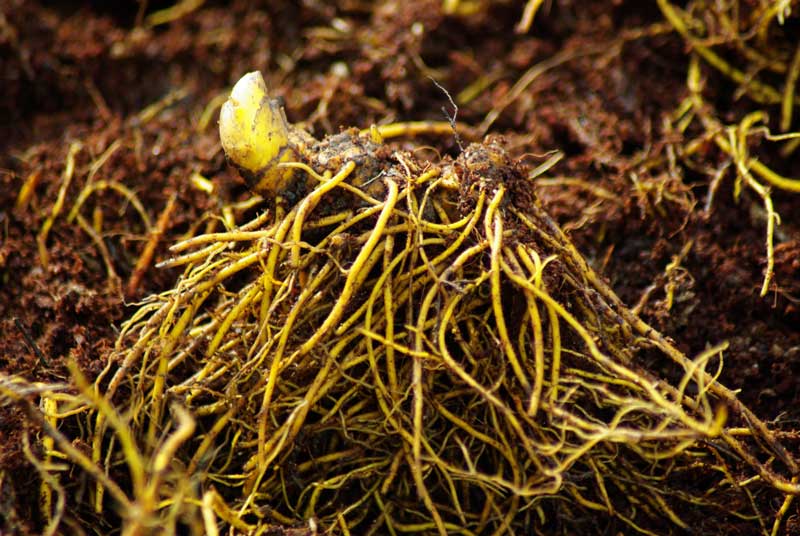
Sandy loam, a substance created by the breakdown of minerals (rock) mixed with the breakdown of carbon (tree or grass detritus). Sandy loam is what we all want, because it is the best all around substrate for growing the plants we love the most: Goldenseal, Ginseng, Black and Blue Cohosh, Wild Yam, Twinleaf, Bloodroot, Stonerooot, Mayapple — the entire interconnected clan of powerfully medicinal shade-loving forest roots. My book “Growing At-Risk” gives a chapter on each of these (and other) herbs of the hardwood forest biome. Let’s look a bit deeper into what can be done to bring these entities down home and help them prosper!
Survey the growing area. It may be a woodland with trees, brush and diverse broadleaf species already intact. If this is the case, identify areas overgrown by weedy species or heavily shaded by dead wood or thin-able trees. Such areas have often been left undisturbed for some time, and the soil may be rich and undisturbed. Clear away dead wood and crowded trees, giving access to the forest floor and providing more light to the growing beds. Forest roots like dappled shade, where sunlight moves across the moist and humus-laden soil in amorphous patches.

After all, even shade-loving herbs eat light! Remove existing weedy species and push your spade into the ground. If you have at least 6 inches of good dirt, then it’s a go. Pull the existing mulch away from the planting bed, which should be at least 4 feet wide, arranged with a path to the side to guide forest creatures and humans away from the planting, not over the top of the sensitive plants. Pile the mulch in the path, and plant the dormant roots in the bed, then rake the mulch back over the top of the bed. Mark the bed with a heavy stake and a label giving the date and the species planted there. Metal tags may be used for this, so that they do not fade or disintegrate with time. You will be oh-so-happy that you marked your planting spot!
Regarding special features such as stumps and rocks, these are not obstacles, they are opportunities! I have seen giant Ginseng growing in the woody debris falling from a rotten stump. I have seen Bloodroot growing in thick moss on a limestone shelf. Adapt to the environment, do not change it, the fertile ground is receptive with opportunity!
Shade gardens can be equally effective places to plant forest roots. However, what is gained by way of ready access, clear paths and easy watering may be lost because the soil is not appropriate. Think about sandy loam. Composed of sand and humus, this may be produced by mixing sand from the quarry and compost from the compost heap. On a micro-scale, one could use chicken grit and a bag of compost from the feed-and-seed, mixed together and mulched with rotted leaves, peat or coir. But if going for a larger scale, it makes sense to order in a truckload of sand and to produce compost on-site with locally available materials. Plan ahead — well-rested soils work better than freshly mixed soils. Good compost takes time. Layer green materials (like fresh leaves or grass clippings) with brown materials (like dead leaves or straw) and throw in some kitchen scraps to get things heating up quickly. Turn the compost several times over the course of a season. Black gold.

Now look at your rootstock. The root is a classic root-rhizome structure, with a bulky rhizome (storage structure) subtended by feeder roots and with a nascent bud or several buds poking out and up. Snip off any rotted portions. It is better to cut back overlong roots than to smash them into the hole at planting. Roots should be trained down and out. Rhizomes generally go parallel with the ground surface. Buds point forward and up. Always tamp the soil around the root to give it a sense of place. Cover the root with mulch. The bud should be protected by at least 2 inches of mulch. Water if rain is not falling. The most successful forest gardeners are planting dormant roots in the fall for emergence in the spring. Don’t worry, in the spring, the bud will elongate into a stem, and if the root is firmly situated, the plant will surely find the way to the light. During dormancy, that is from fall transplant up until spring growth, one might think the roots are just sitting there, but actually they are alive and actively producing feeder roots. This becomes a foundation for the next year’s growth, and is the reason you can’t really successfully transplant in the spring — the root must have a chance to dig in before growing.
Otherwise, a weak plant with no foundation will fall over later, fail to perennialize, and produce a sorry flower that makes no fruit. Remember that perennial forest roots first sleep, then creep, then leap. Honestly if you get powerfully impressive flowering and fruiting plants in the first year you’re lucky. Often it is better for the plant if it just rests the first year, sending up small aerials. Then in the second year it may still look small, but in actuality it is creeping around under the mulch and getting very strong. Then, in the third year, you have not a plant but a patch! I always recommend purchasing and planting in threes (at least).

There are too many likely sources of attrition out there to trust that planting one goldenseal root is going to result in goldenseal for the family medicine cabinet. I also recommend planting diverse species near to each-other. If you go look at the way these plants grow in nature, they are a self-supportive community, not a monocrop. Interplanting helps sequester pollinators and symbiotic mycorrhiza that allow the roots to drink water and eat nutrients. I don’t care how rich the soil is, if the mycorrhizal symbiont is not present, then the plant will not be able to make use of the nutrients! This is why we do not wash our roots when we send them to you. Our hope is that they carry the fungi from our healthy nursery soils with them, and that this will inoculate your soils at planting.

Source link
